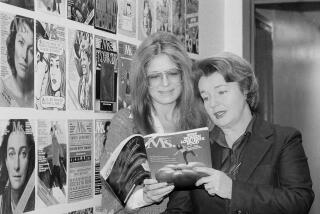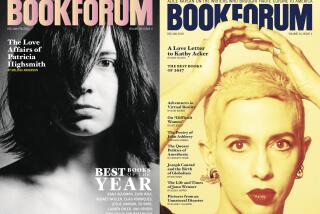A New Voice at Buckley’s Review
Fate and Margaret Thatcher willing, John O’Sullivan will board a New York-bound jetliner late this month, leaving his post as a special adviser to the British prime minister to become editor of National Review, this country’s best known journal of conservative opinion.
O’Sullivan’s trip across the Atlantic from London promises to mark the start of a new era at the magazine, where the title of editor has been held for more than three decades by founder William F. Buckley Jr., columnist, novelist, public affairs television personality, yachtsman, travel writer and general landmark on the American political scene. Buckley, who turns 64 in November, goes upstairs to become editor-in-chief.
‘Most Important Editorship’
“I think the editorship of the National Review is one of the most important editorships in America and therefore the world,” O’Sullivan said Wednesday in a telephone interview from London, where he has been advising Thatcher on defense procurement and Britain’s National Health Service.
Despite his grand vision of the new job, O’Sullivan, 46, portrayed himself as a sort of relief pitcher for Buckley. Noting that Buckley’s wide-ranging outside interests often take him away from the magazine, O’Sullivan said, “I think that my arrival will be a benefit to him in terms of distribution of work.”
For some time, National Review has been getting potshots from critics who claim that Buckley’s frequent absences have hurt the magazine, which they claim needs a more involved editor.
In the May-June issue of the Utne Reader, for example, a columnist complained that the magazine “has lost a lot of its vitality in recent years.” Reason magazine, published by the Libertarian Reason Foundation, says in its July issue that “it has been an open secret for a long time now that NR has been left to drift.”
Buckley Aide Disagrees
National Review’s managing editor, Linda Bridges, said such criticism is unjustified, noting that Buckley’s involvement has remained the same in the 18 years she has been at the magazine. Buckley approves all articles that are published, she said.
Buckley’s office said he was on a sailing trip and could not be reached for comment.
The new editor, who officially signs on Aug. 1, said he has “no blueprint” for the magazine.
O’Sullivan’s Credentials
“My view is that an editor responds to day-to-day events,” O’Sullivan said. “He’s a journalist, not a philosopher.” He said he believes that “readers don’t like dramatic changes” in magazines, preferring instead that a magazine evolve gradually.
O’Sullivan has made a name for himself in conservative circles in the United States. He has been editor of the Heritage Foundation’s Policy Review and also was editorial page editor of the New York Post, as well as doing a stint at Harvard’s Institute of Politics.
In Britain he has worked for a number of newspapers, mainly as an editorial writer and editor of editorial pages.
What can Elizabeth Dole do for Esquire?
Lots, editor-in-chief Lee Eisenberg hopes.
When the magazine’s August issue becomes available next week, Eisenberg is betting that people will talk--either in tones of outrage or approval--about Esquire naming the former Reagan Administration cabinet official and wife of former Republican presidential candidate Kansas Sen. Robert Dole its first Woman of the Year.
“I presume that Mrs. Dole will be a controversial choice,” Eisenberg said in a telephone interview, noting that the issue is timed to coincide with the political convention season. (The Dole decision was made months ago.)
Who Will Be Running Mate?
The issue should also benefit from current speculation about who presumed Republican presidential nominee George Bush will pick as his running mate, Eisenberg added.
Both Elizabeth Dole and her husband have been mentioned as possible vice presidential material. Esquire makes its preference plain by touting Mrs. Dole for the Republican ticket’s second spot. She would “give dimensions to a cardboard candidate,” the magazine proclaims.
“If she was a heartbeat away from him (Bush), it just might assure us that his heart was beating.”
What Dole gets for the honor of being first in the hearts of Esquire’s editors is a two-page black-and-white photo layout of herself shot in the style of old Hollywood studio publicity photos. Dole is seated, looking directly at the camera and wearing a puff-sleeved, metallic ball-gown from her own wardrobe.
Other Features on Women
The homage is included in a package with two other photo features designed to titillate summer readers. In the first, the magazine picks 52 “Women We Love.” The winners include U.S. Supreme Court Justice Sandra Day O’Connor, Soviet first lady Raisa Gorbachev, and singer-actress Madonna. Finally, the magazine drew up a short list of 12 “Women We Don’t Love.” These include actresses Brigitte Nielsen and ShirleyMacLaine, the Duchess of York, British Prime Minister Margaret Thatcher and Miss America, “Whoever she may be.”
Rod & Custom, known to a generation of readers as a magazine small enough to be read while hidden in a high school textbook, is making a comeback after 14 years in automotive never-never land.
The former digest-size monthly will debut as a bimonthly in November in a standard magazine format, said Patrick Ganahl, editor of the magazine at Los Angeles-based Petersen Publishing Co., whose other titles include Motor Trend and Hot Rod.
Die-Hard Readers Expected
Although the reborn magazine won’t be the same size as its previous incarnation, Ganahl suspects that Rod & Custom’s hard-core readership will be die-hard fans from the old days--former car-crazy teen-agers who can’t come close to wearing the same size jeans as in high school but can now afford that ’32 Ford or Chevy.
In his travels around the car show circuit, Ganahl said he’s encountered former readers selling “Bring Back Rod & Custom” T-shirts and has gotten a standing ovation when he announced that magazine would be revved up again. The magazine will cater to car buffs who dote on older street and custom cars but will also include features on vintage drag, sprint and midget race cars, Ganahl said.
To take advantage of the nostalgia for cars from the 1950s and early 1960s, the magazine will also expand its definition of street rodding to embrace post-1949 cars, he added.
Competitive Field Awaits
Predicting a circulation of about 125,000, Ganahl said Rod & Custom will be jumping into a competitive field that already contains at least seven magazines, including Street Rodder and Rod Action.
“The market is incredibly healthy,” he said, adding that one street rod show has doubled in the last five years to 12,000 entries. He also noted that there’s a booming market in fiberglass and steel kit cars faithfully modeled on the hard-to-find originals.
More to Read
Sign up for Essential California
The most important California stories and recommendations in your inbox every morning.
You may occasionally receive promotional content from the Los Angeles Times.










